Walter Sands’ Soft Sandwich Bread
This post may contain affiliate links. Please read my disclosure policy.
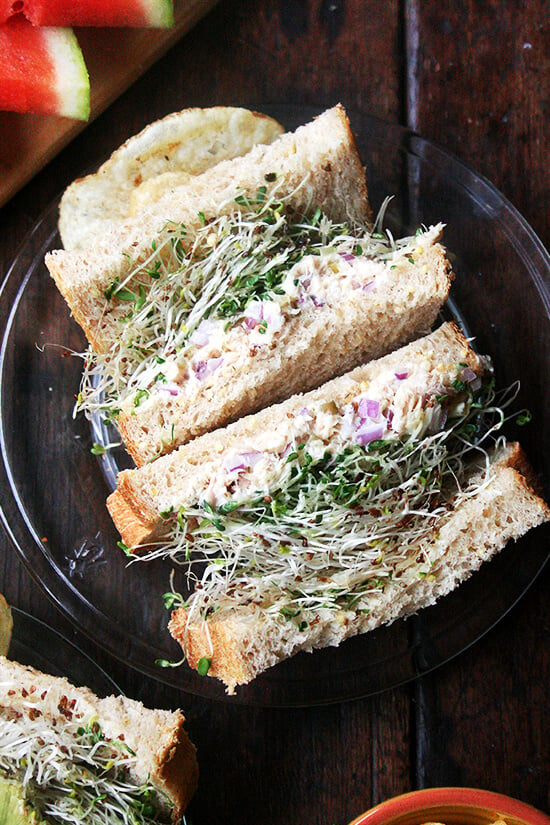
Last weekend, halfway through our drive along the Mohawk Trail en route to a campsite in the Berkshires, we came to a roundabout, which sent us off into a village of green sweeping lawns dotted with stone steeples, brick chapels, farmers’ market signage, and students tossing frisbees. We slowed to take it all in, the utopia that is a college campus.
The following afternoon we returned to Williamstown and guided by an encouraging Yelp review, stopped into Pappa Charlie’s for lunch. We ordered as we always do when we find ourselves in these sorts of spots: anything with tuna for Ben; anything with avocado for me. In a patch of grass just outside the deli, we tucked into our four-inch thick sandwiches teeming with sprouts, dripping with mayonnaise and tomato juices. And although we have eaten this meal countless times in countless places, we relished this lunch, the soft, thick bread, the creamy avocado, the salty chips, the crunchy pickle.
I returned home with classic sandwich bread on the brain, thinking about many a summer meal ahead. This recipe comes from The King Arthur Flour Cookbook and my friend Katie who made beautiful whole wheat loaves after returning from a King Arthur baking seminar last fall.
According to the cookbook, this is the bread Walter Sands, President of Sands, Taylor and Wood Co. (distributor of King Arthur Flour) from 1941 to 1968, made faithfully once a week for years. Because of his arthritic hands, he used a bread bucket with a crank, which over the years kneaded hundreds of loaves of this classic sandwich bread. The bread can be made entirely with whole wheat flour, but I like using a mix of all-purpose and whole wheat flours, which produce a soft, light, and sturdy loaf, one that appeals, most importantly, to both toddlers and adults alike.
Have a great weekend, Everyone.

When the dough pulls from the sides of the bowl and clings to the hook, it’s ready:


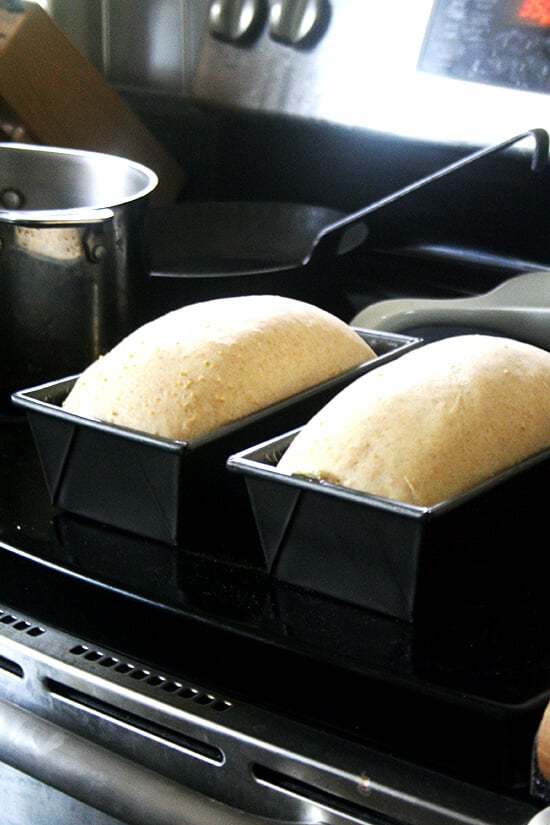
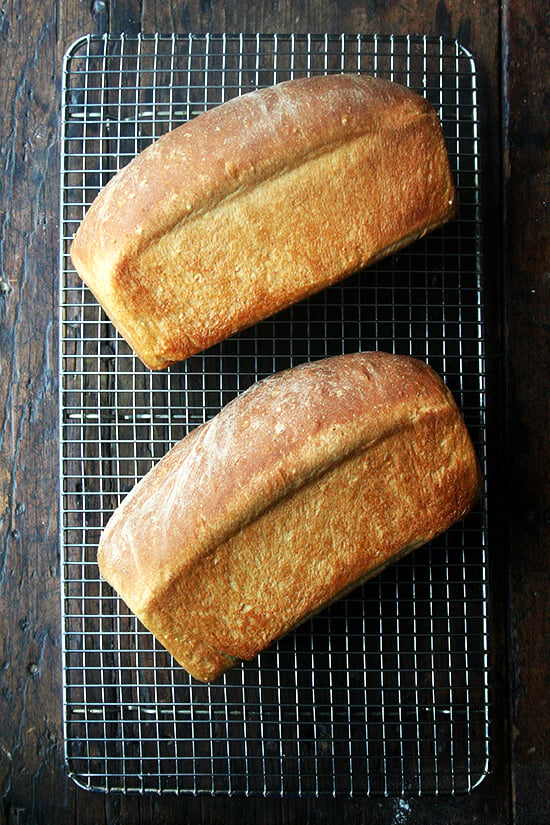
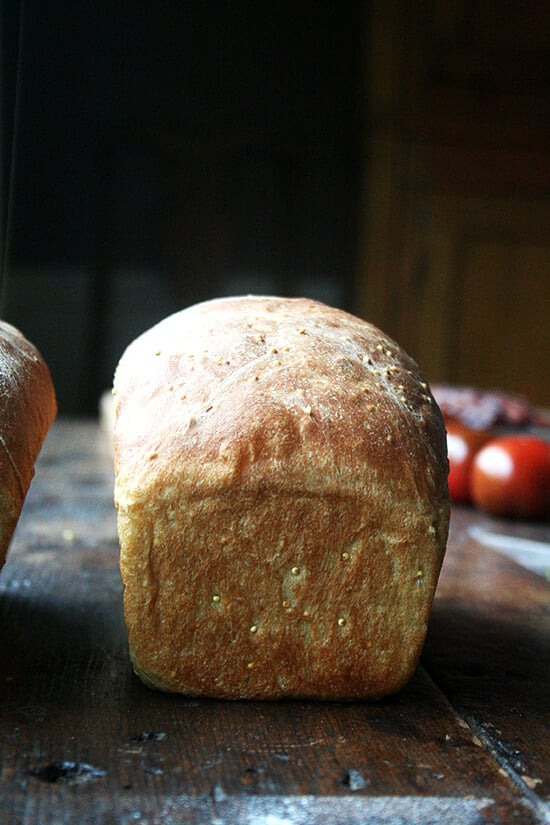
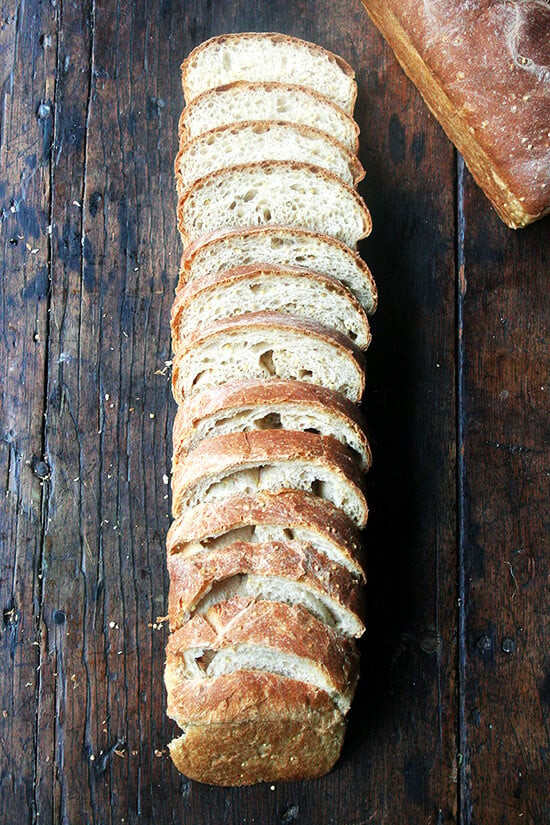
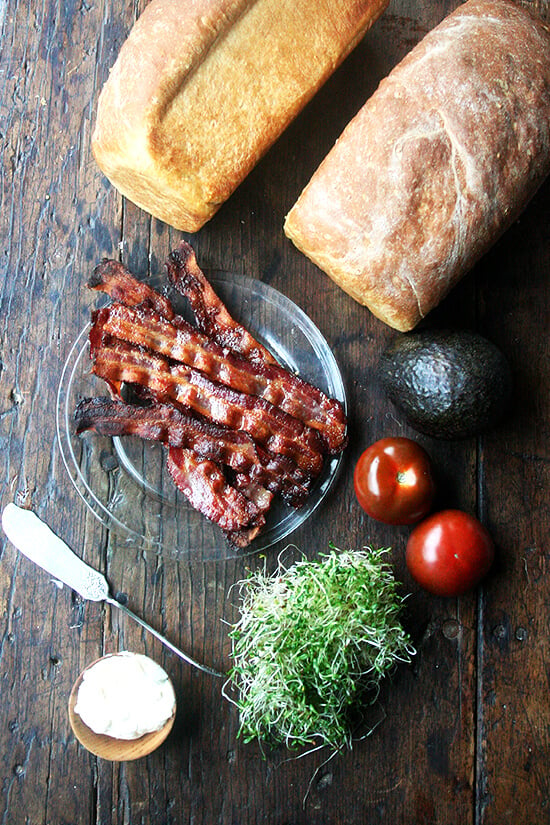
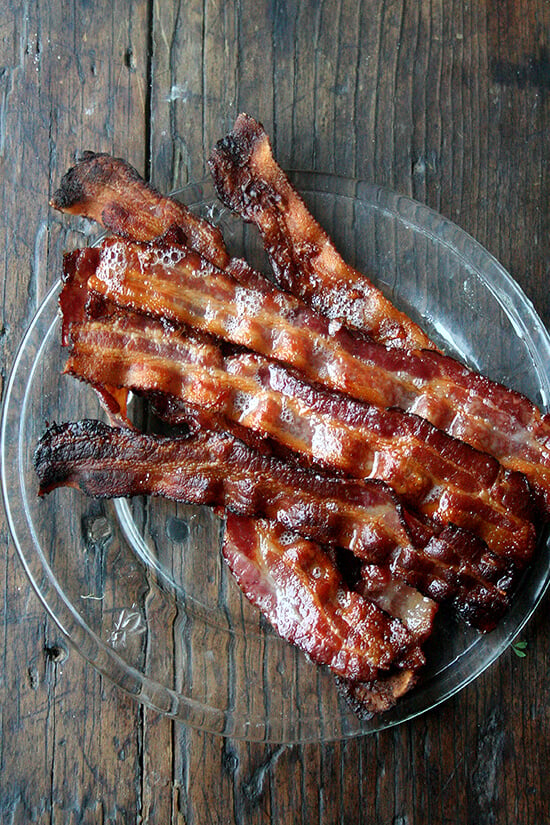
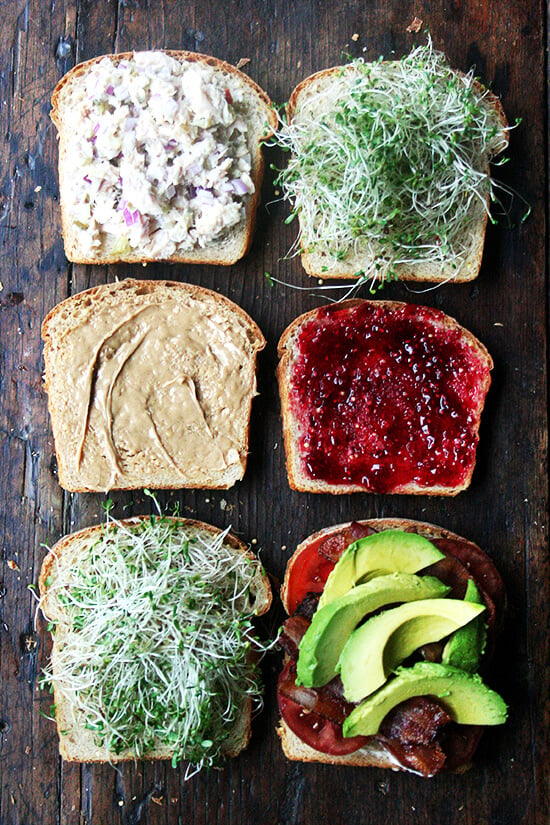
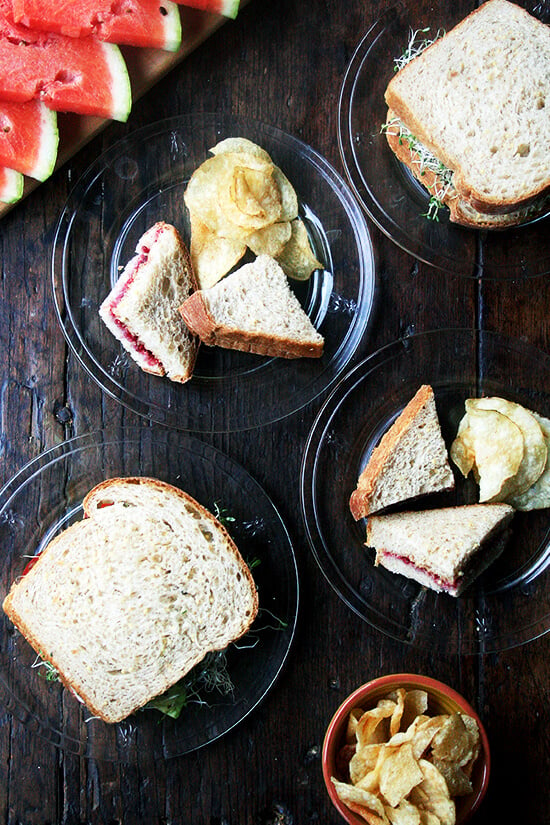
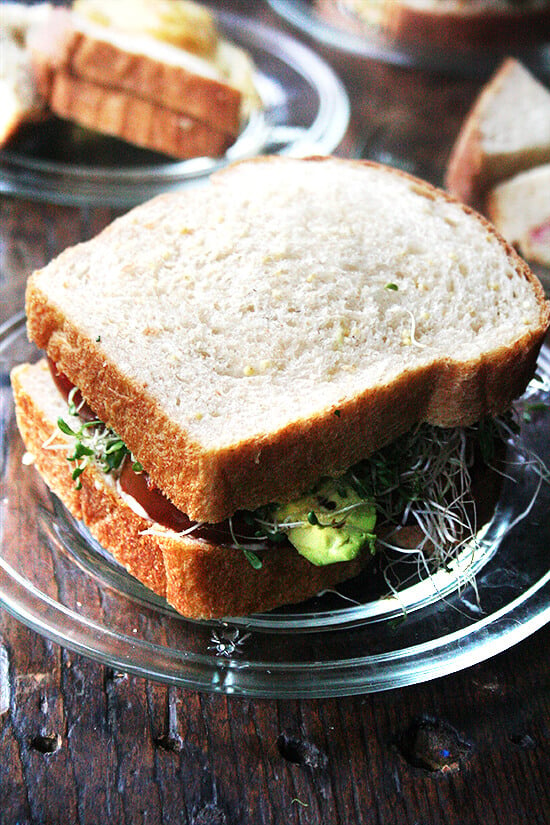

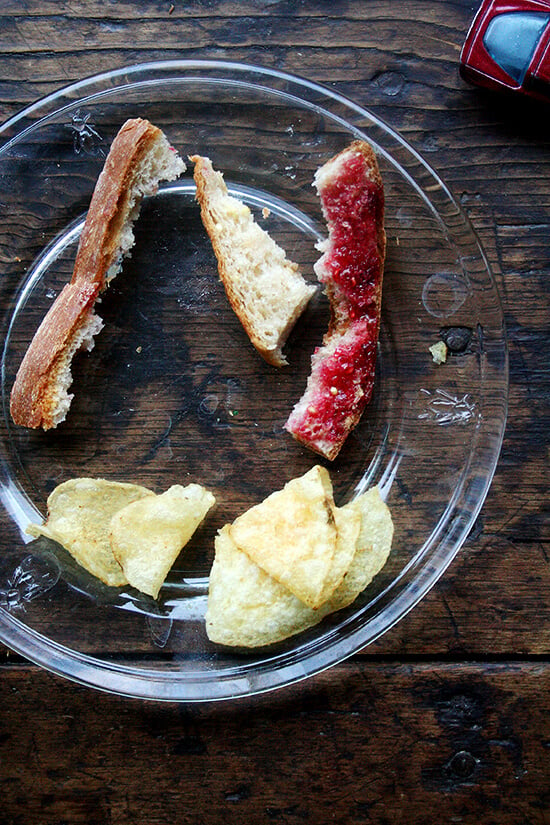

Walter Sands’ Soft Sandwich Bread
- Total Time: 3 hours 60 minutes
- Yield: 2 standard loaves
Description
Adapted from the King Arthur Flour Cookbook
After attending a King Arthur Flour baking tour last fall, my friend Katie posted detailed notes on what she learned along with the recipe for Walter Sands’ Basic White (or Whole Wheat) Bread. She also explains how to do a “head-and-shoulders” shaping technique, which helps prevent air pockets from forming in the finished loaves.
Ingredients
- 2.25 cups (508 g) lukewarm water
- 2 tablespoons (26 g) sugar
- 2 teaspoons (7 g) instant yeast or active dry yeast
- 1/2 cup (56 g) powdered buttermilk or nonfat dry milk
- 2 tablespoons (30 g) soft butter
- 6 cups (765 g) unbleached all-purpose flour
- 5 teaspoons (15 g) kosher salt
Instructions
- (Note: I do this in my stand mixer.) Pour the warm water into a mixing bowl. Add the sugar and then the yeast.
- When the yeast is bubbling, add the butter, the dry milk, the salt, and the flour. Using the dough hook, knead the dough until it begins pulling away from the sides of the bowl and clings to the hook, about 8 minutes total.
- Place the dough in a greased bowl, turn it over to coat all sides, and cover the bowl. Let it rise in a draft-free place until doubled, 1 to 2 hours. Deflate the dough, and divide it in half. Form into loaves and place in well-greased 8 1/2″ x 4 1/2″ loaf pans. Let rise until the dough domes an inch above the rim of the pans, another hour or so.
- After the dough has been rising for 30 minutes, preheat the oven to 350°F. When the loaves are sufficiently risen, bake for 30 to 35 minutes, or until nicely browned. Remove from the oven and tip the breads out of their pans. Place on a rack to cool completely before slicing.
Bacon, Avocado, Sprouts
Preheat oven to 400ºF. Place bacon on a sheetpan and cook for 15 minutes or until bacon is crispy and evenly cooked. Transfer to plate to cool. Spread mayonnaise to taste on one slice of sandwich bread. Top with sliced tomato. Top with bacon. Top with sliced avocado. Top with sprouts. Top with remaining slice of bread. Eat.
Tuna, Salmon or Smoked Trout Salad
Note: Tuna is overfished. American Tuna is one brand that is certified as sustainable by the Marine Stewardship Council. If you can’t find American Tuna (or another brand of sustainably fished tuna), canned wild Salmon (also look for the MSC label) is a good option and so is canned smoked trout. Seafood Watch considers U.S. farm-raised trout to be a “Best Choice” option. I love smoked trout in this very simple salad:
Place tuna, salmon or smoked trout in a bowl. Add finely diced red onion (about 1/2 of a small onion), a spoonful or two of mayonnaise, and a spoonful of relish. Mix, taste, adjust, etc. Spread mayonnaise to taste on one slice of sandwich bread. Top with tuna salad. Top with sprouts. Top with remaining slice of bread. Eat.
Peanut Butter and Jelly
I think you’ve got this one.
- Prep Time: 20 minutes
- Cook Time: 35 minutes
PS: Tarragon Tuna Melt.
A few snapshots from our first camping trip of the season: Wren testing the waters:


Cousin Liam, Graham and Ella ready for a hike:

Back home, driveway fun:
This post may contain affiliate links. Please read my disclosure policy.















109 Comments on “Walter Sands’ Soft Sandwich Bread”
What brand of loaf pans do you use or would recommend? I dabble with bread from time to time and would love to try this. They look so perfect!
The recipe was very easy to follow, and the bread came out really nice and fluffy. Love the color of your beard, this looks wonderful! Thanks for sharing!
Wonderful to hear this, Amy!
I make this bread all the time. My kids love it and it has a bit more utility than baguettes.
One change.I make is to use buttermilk powder instead of the nonfat dry milk. Buttermilk powder gives the bread a wonderful tangy taste and a very soft buttery hue. You can buy a small round carton or an even smaller box, so this might be more practical for the occasional baker. (I wish I could buy ten pounds of it).
This bread makes excellent french toast if you somehow let it get a day or two old. Then if the impossible happens and it get three four days old it makes great croutons or toasted bread.
Glen, thank you so much for your comment — I loved reading about the buttermilk powder. Buttermilk is one of my favorite ingredients, and I love the idea of having it on hand without worrying about it going bad. Added to the grocery list! Thank you thank you. Makes me so happy to read this. I am hungry for French toast. Thanks for writing in.
my go to bread recipe.
I mix flour types, White whole wheat + spelt + AP
sometimes add millet seeds and/or sunflower seeds
never fails.
I love the suggestion to use buttermilk powder. will try it next time!
Can I make this bread in the bread making machine
Hi Mary, I don’t have a bread machine, but if you’ve used yours with success, I would just adapt this recipe the process you typically follow with your bread machine.
Thank you for your reply. I appreciate your input.
I did make this recipe in my bread machine, it turned out great.Not as good as with regular bread Flour but we liked it.
Great to hear, Mary 😍
Hi Alexandra. I just made your peasant bread and it’s wonderful!. I baked it in my 10″x5″ loaf tin as I wanted a rectangular loaf I could slice like sandwich bread. Now I want to try this loaf because of the fluffy and soft texture you describe. Can I bake the entire loaf in my 10″ loaf tin instead of the two 8″ tins as you describe in the recipe? This would also save me the step of dividing the dough into two portions.
Hi Angela! I worry it will be too much dough for your pan and that it won’t bake properly as a result. You can try it of course… just don’t want you to be disappointed.
Thank you for responding and your advice. I will definitely follow!
I’m trying to find where I read about your ratio of whole wheat to all purpose flour for this recipe. I followed that the first time and haven’t found it since. Love the bread!!!
Hi! I can’t seem to find it anywhere either … not sure where that info went. I’m guessing it was 2 cups (255 g) whole wheat flour and 4 cups (510 grams) ap flour. If that doesn’t seem right, it was probably 1 cup whole wheat and 5 cups ap flour … I don’t think I would have done more than 2 cups ww flour. Hope that helps!
I am new to bread baking and been having great success with your recipes! Thanks!!!!
I just started making the bread and I’m at my final proof before the baking (hopefully it will come out well!). I was wondering if it is possible for you to make a video of this recipe. Thanks!!!!
Hi Ada! I will try to make a video of this bread… haven’t made it in ages. Hope it turned out well!
I made this last night when I realized that I was out of sandwich bread for lunches. I’m trying my best to avoid grocery stores since everything is soooo expensive right now. I was cautiously optimistic that it would turn out with a crumb that doesn’t, well, crumble and discingerete when cut like some supposed sandwich loaves I’ve made before. They tasted wonderful (doesn’t all fresh bread??), but it was sometimes impossible to cut neat slices for sandwiches which was always my goal.
This loaf worked amazingly well! I switched out 1 cup of AP flour for Eikhorn flour. Eikhorn takes a while to absorb liquid and doesn’t have much gluten so I gave it 20 minutes after the initial mix to hydrate before kneading and didn’t expect it to rise quite as tall as the loaves in the photos. It came out about as I expected height wise. I suspect if I’d given it another 20-30 minutes of time to rise, it probably would have been much closer to your photos. I’ll do that next round when I’ve got more time to experiment. I may even mess with the ratios to see if I can incorporate more Eikhorn flour and keep the rise. The Eikhorn has a great nutty flavor and creates more of a rustic grain loaf. I like it a lot. Overall, the loaf was incredibly easy to cut into nice slices and tasted amazing. Great for sandwiches and toast!
Great to hear, Stephanie! Thanks so much for writing and sharing your notes. I love the flavor of Einkorn flour as well, and I don’t use it nearly as often as I should. So glad the slices held together!
I hate to say this, but after doing so many recipes from this site, all of of which are awesome, I cannot get this one to work for me. I have tried twice, and as an experienced bread maker, this loaf just wont rise. It looks awesome, but I just cannot replicate and I dont know why.
I’m so sorry to hear this, Scott. I haven’t made this one in ages. I’ll revisit it soon and try to add some notes.
Thanks–the taste is great still overall to mirror those others who have commented, just not the height for a loaf I would want (and my yeast is good!).
And what really drew me to the recipe was the Papa Charlie’s reference. My wife and I went to Williams College and ate there many times!
Truly, I am grateful for the honest feedback because it warns others against making a potentially problematic recipe. I will try to revisit the recipe soon. And I will add gram measurements. I can tell from the size of the photos I’m using my 8.5×4.5-inch loaf pans, and if you are using larger loaf pans, it’s possible that there isn’t enough dough to make a lofty-looking loaf. But I will report back soon!
Hi Ali! This bread is on my list of things to try. In the photos I noticed that there seems to be some type of small seed in the dough, but I don’t see it listed in the recipe. Can you tell me what that is? Looks delicious!
Judy, this is embarrassing, but I don’t know! I’m guessing I threw in a handful of millet or quinoa? I have no recollection of doing that, and there definitely is some sort of seed in there. I think this recipe is pretty forgiving in that regard. I imagine you could add 1/2 cup of seeds and not have to make any other adjustments to the recipe.
I absolutely love all your bread and pizza dough recipes! I’ve made this several times now and wondered if I could add wheat bran to the recipe. Would you recommend and at what ratio?
Thanks!
Great to hear! I have to be honest, I have not baked with much wheat bran, but I would imagine using something like 1/2 cup wheat bran for 1/2 cup of the flour would be fine. You might even be able to do 3/4 cup wheat bran for 3/4 cup of the flour.
Do i need to do anything different if i use glass 9×5 loaf pans?
Nope!
I have some sprouts developing in the pantry–should be ready in a few days, at which point I want to make this bread and do a super sprouty sandwich! One question: you say 2 tsp instant or active dry yeast, and in my experience, it’s necessary to be specific. I use this conversion chart: https://www.theartisan.net/convert_yeast_two.htm. It says 2 instant is like 2.75 active dry. So I’m scared to try and make a mistake here. Have you tried using 2 tsp active dry, and 2 tsp instant, and come up with the same result? Or should I just throw caution to the wind and use 2 tsp of the active dry I have on hand? THANK YOU!
Go with the 2.75 teaspoons active dry… I find a 1:1 swap usually works, but I’d rather you use a bit more to be safe. Good luck!
My dough is bit more wet and sticky than the picture/video, I followed the recipe very detail. But it turned out very well
Great to hear! More wet and sticky is better than too dry… so glad this turned out well 🙂
Delicious, easy seems like a reliable white sandwich bead. Definitely going to be a go-to recipe! SO SOFT! Thanks for sharing!
Great to hear, Dana! Thanks so much for writing 🙂
In the introduction, you mention that you like to use a mix of flours, but there is only AP in the recipe. Can you clear that up for me?
” The bread can be made entirely with whole wheat flour, but I like using a mix of all-purpose and whole wheat flours, which produce(s) a soft, light, and sturdy loaf, one that appeals, most importantly, to both toddlers and adults alike.”
Hi! And apologies for the confusion… I revisited this recipe when someone had trouble with it a few years ago, so I must have changed the flour. If you want to use some whole wheat flour here, I’d use 5 cups (640 grams) ap flour and 1 cup (128 grams) whole wheat flour.
My daughter itroduced me to your blog so I purchased your cookbook for her. She loves it and has made many recipes. She is now an excellent bread maker. I have replaced my mother’s white bread recipe for your white sandwhich bread. Love it and it turns out wonderful every time.
So nice to read this, Carol! Thank you for buying my book for her, and thank you for writing in 🙂